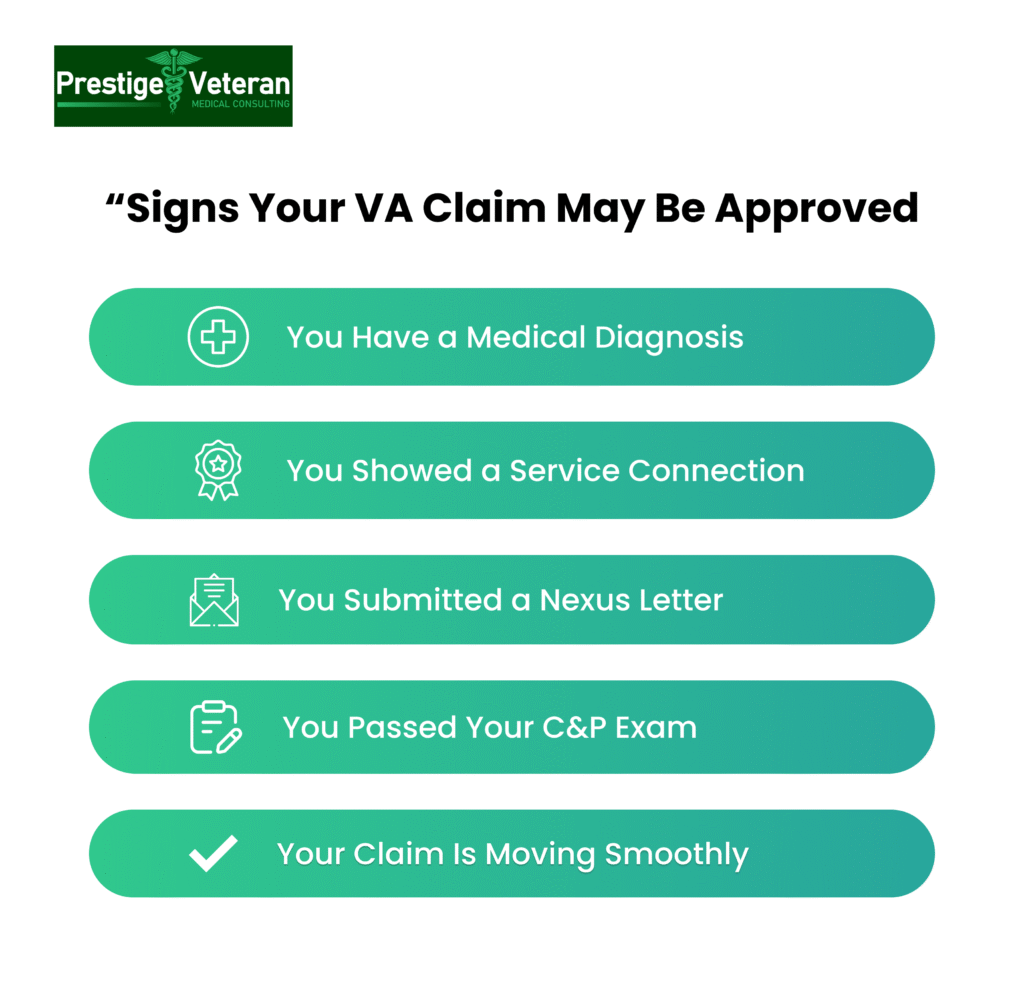Last Updated on 23 July, 2025
Wondering whether your VA disability claim is likely to be approved or not? You’re not alone. As a provider of independent medical nexus letters, we often hear from veterans who are eager to understand their odds of success. While every claim is unique and evaluated based on specific criteria, certain indicators can suggest that your application is on the right track.
Not just that, the VA approved more than 2.5 million disability compensation and pension claims in 2024 alone, setting a new record and surpassing the previous year’s record by 27 percent.
In this blog, we’ll explore key signs that you will be approved for disability benefits and how to enhance your chances. Also, learn how to check your VA claim status.
Disclaimer: The indicators discussed in this article are not guarantees of VA disability claim approval. All VA decisions are made based on applicable law, regulation, and the totality of the evidence in each individual case.
Table of Contents
1. You Have a Clear Service Connection
According to M21-1, Part V, Subpart ii, Chapter 2, Section A, showing a direct service connection between your military service and your current medical condition is one of the most important factors in a VA disability claim.
The Department of Veterans Affairs (VA) requires three main elements to establish this connection:
- A current medical diagnosis of your condition.
- Evidence of an in-service event, injury, or illness that caused or aggravated your condition.
- A nexus (link) or an expert medical opinion connecting your current condition to the in-service event.
If your claim includes solid evidence of these three VA standards, it may result in a favorable finding, an official VA acknowledgment that can be a strong indicator of claim approval. Documented injuries in your service records or diseases caused by VA-recognized presumptive conditions are examples of clear service connections.
2. You Have a Medical Diagnosis of a Current Disability
Without a diagnosis, the VA cannot assess your condition or determine if it’s service-connected.
For your VA disability claim to be approved, you need to have a current, documented medical diagnosis of a condition listed in the Veterans Affairs Schedule for Rating Disabilities (38 CFR Part 4).
Medical documentation from a qualified physician that proves your current disability may include:
- Diagnostic reports
- History of previous conditions
- Imaging results (X-rays or MRI scans)
- Treatment descriptions
- Receipts for medications
Furthermore, alignment between your diagnosis and findings from a Compensation and Pension (C&P) exam is a positive sign for your claim.
Tip: Chances are, the more relevant medical evidence you submit to the VA, the more likely your application may be considered favorably.
3. You Provided Evidence of an In-Service Event or Exposure
To secure VA disability benefits, veterans must prove an in-service event, injury, or exposure caused their condition.
The strongest evidence often includes service treatment records (STRs) documenting medical care received during active duty and service records detailing incidents like falls, fractures, training accidents, or combat injuries.
If official records are unavailable, veterans often submit lay statements describing the event and its impact, supported by buddy statements from fellow service members who witnessed it.
Exceptions to the Standard Evidence Requirements
Certain conditions, such as presumptive conditions and unreported Military Sexual Trauma (MST) claims, don’t require direct proof or event documentation due to their unique circumstances.
Hence, if you have submitted credible evidence of an in-service event and linked it to your diagnosis, your claim may get approved.
4. You’ve Submitted a High-Quality Nexus Letter
If your nexus letter is detailed and written by a reputable doctor, it’s a great sign that your claim has a solid foundation.
A nexus letter is an independent medical opinion (IMO) from a qualified healthcare provider that connects your current diagnosis to your military service. While never mandatory, they can clarify service connection and address gaps in your evidence.
A well-written nexus letter often includes:
- A clear, evidence-based rationale for direct, secondary, or aggravated service connection.
- A nexus statement explicitly linking the condition to the veteran’s military service, using the phrase “as likely as not” to meet VA evidentiary standards.
- References to medical literature, service treatment records, and relevant studies supporting the connection.
- Qualifications of the nexus letter provider to establish credibility.
A strong nexus opinion should be concise, medically sound, and tailored to your case. Avoid generic nexus letter templates that could weaken credibility or even lead your claim to a denial.

5. You’ve Received Favorable Feedback on Your C&P Exam
If you have received favorable verbal or written feedback on your C&P exam, it’s one of the signs that you will be approved for disability benefits.
The Compensation and Pension (C&P) exam is critical in the VA disability claims process, where an examiner assesses your condition to determine the severity and its connection to your service. While the examiner doesn’t make the final decision, their report carries significant weight.
Signs of favorable C&P exam results include:
- The VA-contracted examiner provides an explicit opinion that your condition is “as likely as not” (50/50 probability) connected to your military service.
- Their findings align with your medical records and other submitted evidence.
- You felt the C&P examiner thoroughly evaluated your symptoms and documented them clearly.
Sometimes, veterans feel that the examiner didn’t fully understand their condition or that the C&P results are unfair. In such cases, many veterans challenge bad C&P exams by submitting a written request for a review, providing additional evidence, or including a Memorandum for Record (MFR) to detail any discrepancies.
6. You’ve Submitted All Required Documentation on Time
Providing all required evidence in a timely and comprehensive manner reduces the likelihood of delays or requests for additional evidence.
If you’ve submitted all applicable forms, evidence, and documentation within the given timeframes, you’re taking important steps toward a successful VA claim. For example, filing your claim within a year of discharge may qualify you for presumptive service connection for specific conditions.
Filing a Fully Developed Claim (FDC)
Veterans seeking disability compensation file a Fully Developed Claim (FDC) to ensure they provide all required documentation upfront, helping the VA process and approve their claim more quickly.
An FDC is a complete package including:
- Relevant medical records, both from active duty and after separation
- Supporting buddy letters from colleagues and family
- Personal statements
- Documentation of symptoms and their impact on the veteran’s daily life
This proactive approach also reinforces your commitment to an efficient and timely decision process.
7. You’re Pursuing a Secondary Service Connection
Identifying and filing for secondary connections with additional evidence can strengthen your case and potentially increase your VA disability rating.
Many veterans overlook the opportunity to file for secondary service-connected conditions. For instance, if a service-connected traumatic brain injury has resulted in migraines, the migraines may qualify as a secondary claim.
If your claim has provided strong medical evidence (at times including a nexus letter when applicable) linking your primary service-connected disability to your secondary condition, this could indicate a higher likelihood of approval. Again, if the VA has already acknowledged your primary condition, it will strengthen your secondary claim.
Tip: Consider seeking professional guidance from an accredited legal professional to understand the VA’s process for secondary claims and present your case effectively.
8. Your Condition Qualifies for Presumptive Service Connection
Being diagnosed with a condition on the VA’s Presumptive Conditions List under the PACT Act reduces your burden of proof, as it doesn’t require a direct service connection.
Certain conditions are presumed by the VA to be service-connected based on specific circumstances, referred to as VA presumptive conditions. If you are suffering from one of these, your claim has a high chance of approval.
Here are certain conditions presumed to be service-connected:
- Agent Orange Presumptive Conditions: Diabetes mellitus type 2, certain cancers, and ischemic heart disease for veterans exposed to Agent Orange in Vietnam or other qualifying locations.
- Gulf War Syndrome: Chronic fatigue syndrome, fibromyalgia, and other undiagnosed illnesses for Gulf War veterans.
- Burn Pit Exposure-related Conditions: Respiratory issues, certain cancers, and other toxic exposure illnesses for post-9/11 veterans.
- Former Prisoners of War: Former POWs held captive for more than 30 days are presumed service-connected for conditions like psychosis, anxiety, depression, PTSD, traumatic arthritis, and heart diseases.
VA Claims for Non-Presumptive Conditions
While presumptive service connection gets a faster claim approval, it still requires careful attention. Sometimes, a veteran’s condition may not appear on the VA’s presumptive conditions list for their service era or location. In such cases, solid medical evidence of current diagnosis and service records confirming eligibility is helpful.
9. You Meet the Minimum Rating Criteria
Being aware of the rating criteria for your condition and ensuring your evidence aligns with it is a strong indicator of success.
Each condition in the Schedule for Rating Disabilities has specific criteria for approval. If your symptoms meet or exceed the minimum requirements outlined in the VA’s schedule of ratings, your claim is more likely to be approved if the nexus itself is established.
For example:
- Hearing Loss: If your audiology test results show an average pure tone threshold of 55 dB or more in one ear and speech recognition of 88% or lower, you may qualify for a 20% rating.
- Post-Traumatic Stress Disorder: If you experience occupational and social impairment with reduced reliability and productivity due to symptoms like panic attacks more than once a week or impaired judgment, you may qualify for a 50% PTSD rating.
- Knee Replacement: If you have chronic residuals such as severe painful motion or weakness in the affected limb following a knee replacement, you may receive a 60% disability rating.
- Sleep Apnea: If you experience persistent daytime hypersomnolence (excessive daytime sleepiness) due to sleep apnea and do not yet require a CPAP machine, you may qualify for a 30% rating.
10. The VA Actively Fulfills Its Duty to Assist
As mentioned in M21-1, Part I, Subpart i, Chapter 1, Section A, VA has a duty to assist claimants in obtaining evidence needed to support their claims, including relevant federal and private records.
The VA has a duty to assist veterans in gathering evidence for their disability claims. While it may seem counterintuitive, a VA request for additional information, such as updated medical test results, service personnel records, or lay statements from family or fellow service members, can be a positive sign. It likely means your claim is under “active review”, and the VA is ensuring all necessary evidence is in place for a fair decision.
Signs that the VA is fulfilling its duty include:
- Scheduling Compensation and Pension (C&P) exams
- Providing medical opinions
- Guiding veterans on missing information
- Maintaining follow-up communication
If the VA is asking questions, it usually indicates that your claim has potential and is being carefully considered.
11. You Have Strong Lay Statements or Buddy Letters
Under M21-1, Part V, Subpart ii, Chapter 1, Section B, lay evidence may be used to prove service incurrence or aggravation, especially when service treatment records are missing.
Lay statements, written by you, family members, or close friends, describe observable symptoms and their progression, functional limitations, and the impact on your daily life. These personal testimonies help illustrate the severity and frequency of your symptoms, especially in cases where medical records alone may not fully capture your struggles.
Buddy statements from fellow service members may corroborate in-service events, injuries, or exposures that led to your condition. These statements add credibility by providing firsthand accounts of incidents that may not be thoroughly documented elsewhere.
When submitting a VA disability claim, having well-documented lay statements or buddy letters can significantly strengthen certain veteran cases.
12. Your Claim Has Smoothly Progressed Through the System
If your VA claim is progressing without delays or requests for clarification, it may be a sign that your case is well-documented and leading towards an approval.
The VA takes an average of 107.4 days to approve a disability claim, which is approximately 3.5 months. However, disputed cases can take anywhere from several months to a year or longer.
However, a fast timeline doesn’t guarantee approval, and delays don’t necessarily mean denial. The VA’s processing times can vary based on factors like workload, the complexity of your case, or regional office capacity.
Tip: Staying responsive to VA’s requests to provide evidence can help veterans avoid unnecessary delays.
Disclaimer: This content is for informational purposes only and does not constitute legal or medical advice. For official guidance, refer to the M21‑1 Adjudication Procedures Manual.
Consider working with a VA-accredited representative, attorney, claims agent, or Veteran Service Organization (VSO) that can assess the likelihood of your claim’s success based on your evidence.
How to Track Your VA Claim Status Online
Wondering about the status of your VA disability claim? The Department of Veterans Affairs has made it easier than ever to check your claim online through VA.gov and the eBenefits portal. Staying updated on your VA claim status helps you anticipate decisions and respond promptly to requests.
To check your VA claim status online:
- Visit VA.gov
- Sign in using a Login.gov, ID.me, DS Logon, or My HealtheVet account.
- Once logged in, click “Track Claims” to view the progress of your disability claim, appeal, or decision review.
Once logged in, view updates such as:
- The ongoing step in your VA claim (e.g., Evidence Gathering, Preparation for Decision)
- Documents or evidence you have submitted
- VA requests for additional information
- Any Compensation & Pension (C&P) exams scheduled
If you filed through the Fully Developed Claim (FDC) program, your claim may move through the process faster, and updates will reflect that.
Tip: If your VA claim status hasn’t changed in 30+ days, or if no evidence is marked as received, consider calling at 1-800-827-1000 or contacting your VSO to check your file through the VBMS (Veterans Benefits Management System).
What if Your VA Claim Was Disapproved or Underrated?
If your VA disability claim was denied or rated unfairly, you still have options under the Appeals Modernization Act (AMA). You can choose from three different appeal paths, all explained well on the VA Decision Reviews & Appeals Page:
- Higher-Level Review: A senior VA reviewer conducts a second look at your original claim for errors.
- Supplemental Claim: Submit new and relevant evidence, e.g., updated diagnostic test results or an additional nexus letter.
- Board of Veterans’ Appeals: Request a formal review or hearing in front of a Veterans Law Judge for reconsideration.
Veterans can appeal within one year of the VA decision. Learn how to choose the best option for your case in the VA guide to decision review options, or work with professionals like a VSO or VA-accredited attorney who understands the process.
These professionals assist veterans gather evidence, present their cases effectively, and advocate or guide them through appeals if needed.
Conclusion
While no single factor guarantees VA disability claim approval, strong evidence and thorough documentation significantly increase your chances. Each case is unique, and approval ultimately depends on the evidence presented and the VA’s evaluation. Staying proactive, gathering relevant documentation, and seeking expert guidance from accredited legal professionals can help you navigate the system more effectively. If you’re unsure about your claim’s strength or need assistance, consulting with professionals who specialize in VA claims can be a valuable step toward securing the benefits you deserve.
Need Help Strengthening Your Claim?
If you believe a nexus letter could help your case, Prestige Veteran can provide Independent Medical Opinions (IMOs) written by licensed professionals well-versed in the medical opinion aspects of the VA claims process.
FAQs
What are the signs that my VA claim will be approved?
You can never absolutely tell if you will be approved for VA disability, but some positive signs include having a well-documented medical diagnosis, clear evidence of service connection, a strong nexus, and favorable C&P exam results.
How long before a VA claim is approved?
The VA typically takes around 107 days (about 3.5 months) to approve a disability claim, though complex cases can take longer.
How do I know if my VA claim was approved?
You can track your VA claim status online through VA.gov or the eBenefits portal, where an official decision will be posted once made. The VA will also notify you of your disability claim approval through an official decision letter sent by mail.
How often does VA update claim status?
The VA updates claim statuses regularly, especially when documents are submitted or a new phase begins, but if no update appears in over 30 days, veterans should follow up.
What is the easiest VA disability claim to win?
Claims based on VA-recognized presumptive conditions are often the easiest to win due to reduced evidence requirements, such as those linked to:
- Agent Orange
- Gulf War
- Burn pit exposure
- Atomic radiation
- Combat PTSD
- Toxic exposure illnesses like Camp Lejeune contamination and others.
What’s the fastest a VA claim can be approved?
The fastest a VA claim can be approved is within 30 days through the Decision Ready Claims (DRC) program, when you submit all relevant evidence in coordination with an accredited Veterans Service Organization (VSO).
Also read: Most Common VA Disability Claims and How To Prove Service Connection
At Prestige Veteran Medical Consulting, a veteran-owned company, we specialize in Independent Medical Opinions (IMOs) known as Nexus letters.
Our purpose is to empower YOU, the veteran, to take charge of your medical evidence and provide you with valuable educational tools and research to guide you on your journey.
Understanding the unique challenges veterans face, our commitment lies in delivering exceptional service and support.
Leveraging an extensive network of licensed independent medical professionals, all well-versed in the medical professional aspects of the VA claims process, we review the necessary medical evidence to incorporate in our reports related to your VA Disability Claim.
Prestige Veteran Medical Consulting is not a law firm, accredited claims agent, or affiliated with the Veterans Administration or Veterans Services Organizations. However, we are happy to discuss your case with your accredited VA legal professional.















2 Responses
Great information
Thank you!